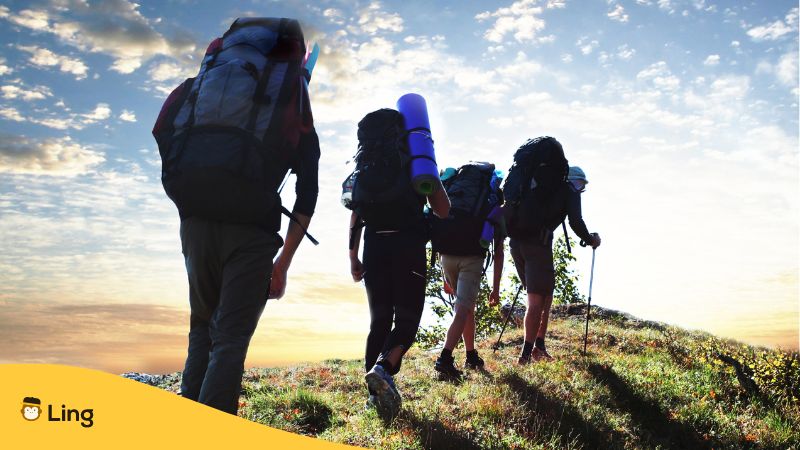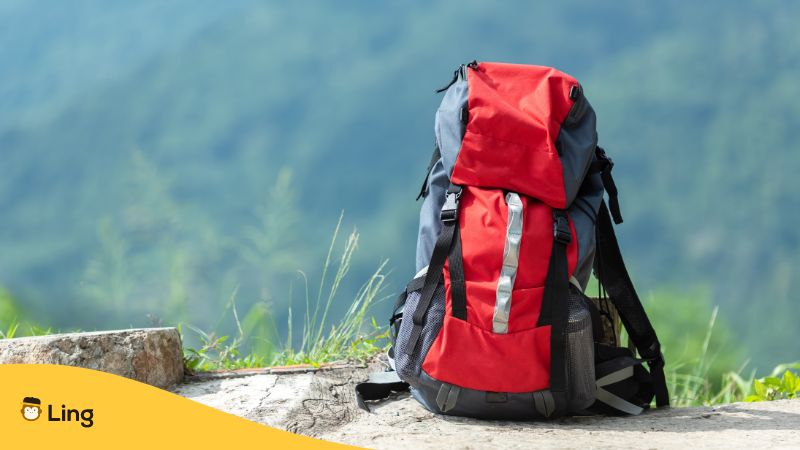Have you ever tried hiking in Japan’s awe-inspiring wilderness, surrounded by ancient forests and breathtaking mountain vistas? If you did it before, then why not try it again, but this time, you’re armed with the ultimate secret weapon – an arsenal of Japanese words for hiking? Not only will you navigate the trails like a seasoned pro, but you’ll also do so in the language of the land. Curious? Let’s begin!
What Is “Hiking” In Japanese?
In the Japanese language, ハイキング (はいきんぐ or Haikingu) is the direct translation for “hiking.” Now, you might wonder, “Why does this look and sound so familiar?” That’s because it’s a direct adaptation of the English word “hiking,” transformed into its Japanese avatar with a gentle swing of linguistic magic.
According to the locals, hiking is one of the top outdoorsy hobbies that is open to all, from lively toddlers attempting their first steps to spirited nonagenarians who’ve been hitting the trails since before their parents were born. The こども (こども or Kodomo), meaning children, go on a hike to marvel at the fireflies and scamper across brooks, while the ろうじん (ろうじん or Roujin) meaning elders, recount folklore, share wisdom, and sometimes, stealthily sneak in the best trail snacks. The energy of the young and the wisdom of the old paint a vibrant picture of Japanese hiking, or should we say ハイキング (はいきんぐ or Haikingu) culture!
Every country has its signature landscape, and Japan is no different. The landscape is beautifully varied; you’d scarcely believe you’re still in the same country as you traverse from rolling countryside hills to steep mountainous terrains. Walking the 山道 (やまみち or Yamamichi), meaning mountain paths, amidst an explosion of cherry blossoms or autumnal hues – that’s the panoramic appeal of hiking in Japan. Equal parts serene and thrilling, the trails reflect the country’s heart in their embrace of nature, seasons, and harmony.

Common Japanese Words For Hiking
Embarking on a Japanese hiking adventure? Turn your trailblazing escapade up a notch! With these common Japanese words related to hiking in your backpack, you’ll be soaring through the language barriers like a seasoned pro. Let’s dive in!
Mountain – 山 (やま or Yama)
Let’s start with the star of every hike – the Mountain, or Yama in Japanese. The majestic Yama that dot Japan’s landscape aren’t just enormous heaps of rocks and soil. They are sacred places, seeped in ancient folklore, spirituality, and natural beauty, inviting hikers to embark on a journey that’s as enriching as it is challenging.
Forest – 森 (もり or Mori)
As the sunlight filters through the dense foliage, creating a kaleidoscope of shadows on your path, you’re truly experiencing the magic of the Mori (Forest). A hiking adventure in Japan wouldn’t be complete without losing oneself in the enchanting Mori, home to an incredible biodiversity.
River – 川 (かわ or Kawa)
Dancing around rocks and frolicking through valleys, the Kawa (River) adds a lively rhythm to any hiking trip. Whether you’re crossing a nimble brook or resting by the serene banks of a Kawa, it’s never just about the water – but the life and energy it brings to the landscape.
Path – 道 (みち or Michi)
Neon signs and bustling streets might paint one picture of Japan, but on the Michi (Path or road), you meet another Japan. Peaceful, rustic, and laden with the whispers of countless travelers who’ve tramped along before you. Every Michi you traverse brings its own story and experience – a tangible touch of the country’s essence.
Map – 地図 (ちず or Chizu)
Meet your trusty sidekick on your Japanese hiking expeditions – the Chizu (Map). With your Chizu in hand, you’re not just deciphering the route to your next pit-stop but sketching out the contours of your next adventure story.
First Aid Box – 救急箱 (きゅうきゅうばこ or Kyuukyuubako)
Never underestimate the importance of packing a Kyuukyuubako (First aid box) when setting off for a hike. It’s not just a box; it’s your safety net, holding everything from band-aids to survival blankets. So, remember to stow your Kyuukyuubako in your backpack before hitting the Michi!
Friends – 友達 (ともだち or Tomodachi)
Hiking in Japan isn’t merely a pastime; it’s a communally loved activity. And what better way to experience it than with your Tomodachi (Friends)? Share laughter, experiences, and make memories – after all, the trails are best enjoyed in good company.
Backpack – バックパック (Bakku Pakku)
Don’t leave your camping gear behind! ‘Bakku Pakku’, translating to ‘backpack’, is essential for every hiking journey. It’s a ‘carry-all’ quite literally!
Weather – 天気 (Tenki)
Rain or sunshine? Know before you go! ‘Tenki’ is your ‘weather’ guide. Because having a ‘tenki’ chat before ‘tozan’ could save your day!
Water – 給水 (Kyūsui)
Last but definitely not least, stay hydrated, fellow hikers! Keep refilling your ‘kyūsui’, ‘water supply.’ It’s no ‘water under the bridge’ but ‘water in your backpack’!

What To Pack For A Hike
Whether you’re out there chasing sunsets or climbing your way to new personal heights, what you pack is just as important as where you track. Here is a list of essential items and their Japanese counterparts for every hiking foray!
- Water (水 or Mizu): Be it a gentle stroll or a steep climb, the Mizu goes in before the sweat comes out. Don’t underestimate the power of hydration! In Japan, you may also purchase jelly packs and hydration powders that you mix with your water to help you replenish fluids and electrolytes.
- Food (食べ物 or Tabemono): Keeping up with the calories on a hike? Enter Tabemono. Snacks or a packed lunch not only refuel your energy but also make for a memorable meal amidst nature. Trail mix, anyone?
- First Aid Kit (救急箱 or Kyuukyuubako): Cuts, bruises, or blisters, a Kyuukyuubako is your first line of defense against small injuries. This is not just a box; it’s your in-pocket paramedic.
- Clothing (服 or Fuku): From water-wicking shirts to the extra pair of socks, your Fuku should always answer to the weather gods. For this, the locals usually recommend Uniqlo’s Airism line or any outfit made of spandex material.
- Flashlight (懐中電灯 or Kaichuudentou): ‘Cause the wild doesn’t come with street lights! When you need to find your path in the dark or simple reading, a Kaichuudentou pulls off the magic.
- Camera (カメラ or Kamera): Adventure lived is an adventure remembered! Capture every breathtaking moment with a Kamera, because, aren’t life’s best souvenirs free?
Make sure these items find a place in your Bakku pakku before you set off to explore Japan’s mystical mountains or verdant landscapes. And with the Japanese terms tossed in now, we can bet you’d be as impressive cohiker on the trails. Haikingu ni ikou, let’s go hiking!
Learn Japanese With Ling
From navigating the lush shinrin to understanding the legend of yama, we’ve traveled far in our hiking adventure and language expansion. Our trusty chizu leading the way, we’ve unlocked a treasure trove of Japanese terms that turn any hiking experience into a linguistic exploration.
But why stop here when there’s a whole mountain range of words left to conquer? Gearing up for your next language expedition is as simple as unlocking your phone! If you have been bitten by the Japanese bug, and your linguistic journey is just about to start, don’t fret. All you need is our dynamic language-learning friend, the Ling app.
Not only will the app guide you through the valleys and peaks of Japanese vocabulary and grammar structures, but it also ensures your ascent is steady, manageable, and enjoyable. With Ling, each tap on your screen brings you one step closer to mastering the suave cadences of the Japanese language.
Why wait for the learning to come to you when you can carry your virtual tutor in your pocket? Download the Ling app from the App Store or Play Store today, and move towards language proficiency like a seasoned linguistic mountaineer!



































































